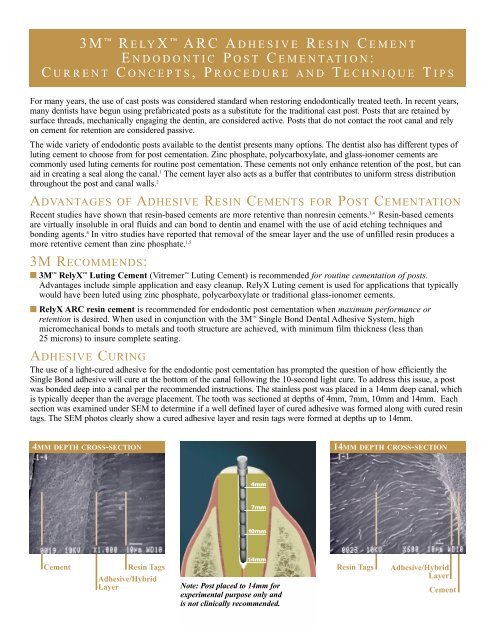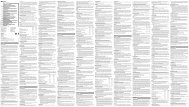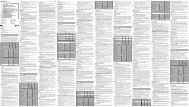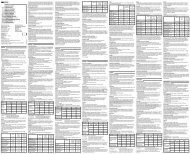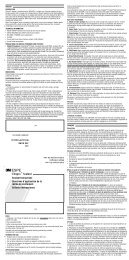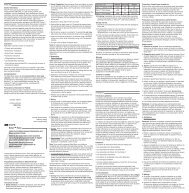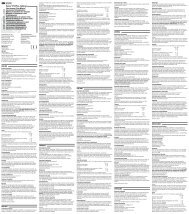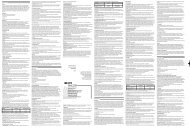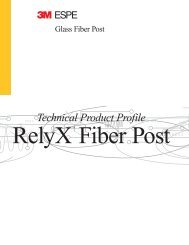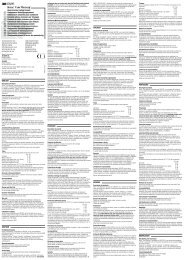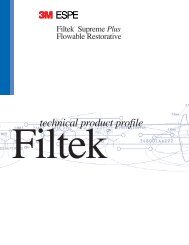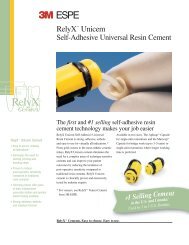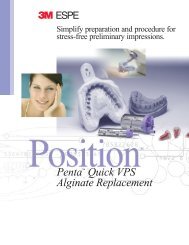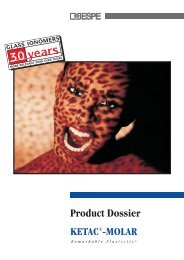3M(tm) RelyX(tm) ARC
3M(tm) RelyX(tm) ARC
3M(tm) RelyX(tm) ARC
You also want an ePaper? Increase the reach of your titles
YUMPU automatically turns print PDFs into web optimized ePapers that Google loves.
<strong>3M</strong> R ELYX <strong>ARC</strong> ADHESIVE R ESIN C EMENT<br />
E NDODONTIC P OST C EMENTATION:<br />
C URRENT C ONCEPTS, PROCEDURE AND T ECHNIQUE T IPS<br />
For many years, the use of cast posts was considered standard when restoring endodontically treated teeth. In recent years,<br />
many dentists have begun using prefabricated posts as a substitute for the traditional cast post. Posts that are retained by<br />
surface threads, mechanically engaging the dentin, are considered active. Posts that do not contact the root canal and rely<br />
on cement for retention are considered passive.<br />
The wide variety of endodontic posts available to the dentist presents many options. The dentist also has different types of<br />
luting cement to choose from for post cementation. Zinc phosphate, polycarboxylate, and glass-ionomer cements are<br />
commonly used luting cements for routine post cementation. These cements not only enhance retention of the post, but can<br />
aid in creating a seal along the canal. 1 The cement layer also acts as a buffer that contributes to uniform stress distribution<br />
throughout the post and canal walls. 2<br />
ADVANTAGES OF ADHESIVE RESIN CEMENTS FOR POST CEMENTATION<br />
Recent studies have shown that resin-based cements are more retentive than nonresin cements. 3,4 Resin-based cements<br />
are virtually insoluble in oral fluids and can bond to dentin and enamel with the use of acid etching techniques and<br />
bonding agents. 4 In vitro studies have reported that removal of the smear layer and the use of unfilled resin produces a<br />
more retentive cement than zinc phosphate. 1,5<br />
<strong>3M</strong> RECOMMENDS:<br />
■ <strong>3M</strong> <strong>RelyX</strong> Luting Cement (Vitremer Luting Cement) is recommended for routine cementation of posts.<br />
Advantages include simple application and easy cleanup. <strong>RelyX</strong> Luting cement is used for applications that typically<br />
would have been luted using zinc phosphate, polycarboxylate or traditional glass-ionomer cements.<br />
■ <strong>RelyX</strong> <strong>ARC</strong> resin cement is recommended for endodontic post cementation when maximum performance or<br />
retention is desired. When used in conjunction with the <strong>3M</strong> Single Bond Dental Adhesive System, high<br />
micromechanical bonds to metals and tooth structure are achieved, with minimum film thickness (less than<br />
25 microns) to insure complete seating.<br />
ADHESIVE CURING<br />
The use of a light-cured adhesive for the endodontic post cementation has prompted the question of how efficiently the<br />
Single Bond adhesive will cure at the bottom of the canal following the 10-second light cure. To address this issue, a post<br />
was bonded deep into a canal per the recommended instructions. The stainless post was placed in a 14mm deep canal, which<br />
is typically deeper than the average placement. The tooth was sectioned at depths of 4mm, 7mm, 10mm and 14mm. Each<br />
section was examined under SEM to determine if a well defined layer of cured adhesive was formed along with cured resin<br />
tags. The SEM photos clearly show a cured adhesive layer and resin tags were formed at depths up to 14mm.<br />
4MM DEPTH CROSS-SECTION<br />
14MM DEPTH CROSS-SECTION<br />
4mm<br />
7mm<br />
10mm<br />
Cement<br />
Resin Tags<br />
Adhesive/Hybrid<br />
Layer<br />
14mm<br />
Note: Post placed to 14mm for<br />
experimental purpose only and<br />
is not clinically recommended.<br />
Resin Tags<br />
Adhesive/Hybrid<br />
Layer<br />
Cement
<strong>3M</strong> R ELYX <strong>ARC</strong> ADHESIVE R ESIN C EMENT<br />
P OST C EMENTATION T ECHNIQUE<br />
P RODUCTS R EQUIRED:<br />
■ Endodontic Post<br />
■ <strong>3M</strong> Scotchbond Etchant<br />
■ <strong>RelyX</strong> <strong>ARC</strong> resin cement<br />
■ <strong>3M</strong> Single Bond Dental Adhesive System<br />
■ Paper Points (for removal of excess material) ■ <strong>3M</strong> Curing Light 2500 or <strong>3M</strong> Curing Light XL 3000<br />
■ <strong>3M</strong> <strong>RelyX</strong> Ceramic Primer<br />
Prepare the endodontically<br />
treated tooth to receive the post.<br />
Tip: Trial fit and adjust post as<br />
needed prior to cementation.<br />
Etch preparation for 15 seconds,<br />
rinse for 10 seconds.<br />
Blot dry excess water.<br />
Tip: Remove excess moisture<br />
with an absorbent paper point.<br />
Apply Single Bond adhesive<br />
to etched enamel and dentin.<br />
Dry for 5 seconds.<br />
Important Tip: Remove<br />
excess pooled adhesive with<br />
an absorbent paper point. This<br />
will help to insure proper fit.<br />
Tip: Position light guide<br />
directly above the prep.<br />
Light cure for 10 seconds.<br />
Note: See reverse side for<br />
details regarding Single Bond<br />
adhesive curing efficiency in<br />
post preparations.<br />
Tip: It’s good clinical practice<br />
to trial fit the post again, prior<br />
to cementation.<br />
Apply <strong>RelyX</strong> ceramic primer to<br />
post. Dry for 5 seconds.<br />
Tip: Bonds to cast posts can<br />
be enhanced by air abrasion,<br />
Dispense the appropriate<br />
amount (Tip: 3 clicks) of<br />
<strong>RelyX</strong> <strong>ARC</strong> resin cement<br />
onto a mixing pad and mix<br />
for 10 seconds. Apply cement<br />
to the bonding surface of the<br />
preparation. Place a thin layer<br />
of cement on the post.<br />
Seat the post. While holding in<br />
place, remove excess cement.<br />
Optional Tip: Instead of<br />
immediate clean-up, wait<br />
3–5 minutes, then “flick”<br />
excess cement from margins<br />
with an explorer.<br />
Light cure for 40 seconds from<br />
the occlusal surface to allow<br />
immediate placement of core<br />
build-up material.<br />
Photos courtesy of<br />
Robert A. Lowe, DDS,<br />
Chicago, IL<br />
3<br />
Dental Products<br />
<strong>3M</strong> Center, Building 275-2SE-03<br />
St. Paul, MN 55144-1000<br />
1 Sivers JE, Johnson WT: Restoration of endodontically treated teeth. Dent Clin North AM 36:631-648, 1992.<br />
2 Standlee JP, Caputo AA, Collard EW. et al: Analysis of stress distribution by endodontic posts. Oral Surg 33:952-960, 1972.<br />
3 Shillingburg HT, Hobo S, Whitsett LD, et al: Fundamentals of Fixed Prosthodontics, ed 3. Chicago, Quintessence, pp 194-208, 1997.<br />
4 Anusavice KI: Science of Dental Materials, ed 10. Philadelphia, WB Saunders Co, pp 555-580, 1996.<br />
5 Mendoza DB, Eakle WS: Retention of posts cemented with various dentinal bonding cements. J Prosthet Dent 72:591-594, 1994.<br />
* Refer to instructions for precautionary, detailed use, storage and warranty information.<br />
Recycled paper<br />
40% pre-consumer<br />
10% post-consumer<br />
Printed in the U.S.A.<br />
© <strong>3M</strong>, 1999.<br />
70-2009-2081-0


